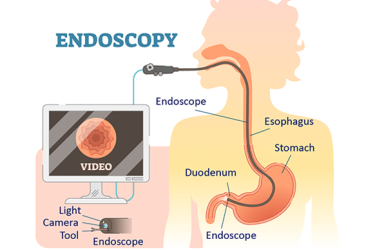
Endoscopy is a diagnostic test to look inside the body. The endoscopy procedure uses an endoscope to examine the interior of a hollow organ or cavity of the body. Unlike many other medical imaging techniques, endoscopes are inserted directly into the organ. The endoscope is a flexible wire which has an LED Light at the tip and a camera. Once this is inserted inside the body through any opening, it beams images of the inside which are seen on a computer screen.
There are many types of endoscopes. Depending on the site in the body and type of procedure an endoscopy may be performed either by a doctor or a surgeon. A patient may be fully conscious or anaesthetised during the procedure. Most often the term endoscopy is used to refer to an examination of the upper part of the gastrointestinal tract, known as an Esophago-gastro-duodeno-scopy or commonly as Upper GI Endoscopy.

When an endoscope is used to explore any part of the body, it is named as follows:
 Upper GI Endoscopy - Oesophagus, Duodenum and Stomach
Upper GI Endoscopy - Oesophagus, Duodenum and Stomach
 Enteroscopy - Small Intestine
Enteroscopy - Small Intestine
 Colonoscopy - Large Intestine
Colonoscopy - Large Intestine
 Sigmoidoscopy - Colon
Sigmoidoscopy - Colon
 ERCP - Bile Duct
ERCP - Bile Duct
 Bronchoscopy - Lungs
Bronchoscopy - Lungs
 Colposcopy - Cervix
Colposcopy - Cervix
 Arthroscopy - Joints
Arthroscopy - Joints
Mostly children come to the hospital where they have ingested a coin or something similar and the foreign body is either inside the throat, stomach or sometimes into the lungs then endoscope is used to remove the foreign body. Adults using foreign objects into the rectum also need to be rushed to the emergency in some cases.

The preparation for the endoscopy depends on the organ that needs to be examined. So if the Upper GI Endoscopy is to be done then the stomach should be completely empty. The patient should not eat anything after the dinner on the previous night. Some medications are given after dinner so that the digestive system is clean in the morning. The patient has to report without even a glass of water because anaesthesia is used otherwise the test can be quite difficult for the patient since a wire is inserted through your mouth.
For colonoscopy the rectum or the gut has to be completely clean otherwise the images sent by the colonoscope would not be clear. For other scopies the preparation remains the same if anaesthesia is to be used which is the case with most of the scopies except proctoscope which doesn't go very far into the rectum and is mostly used to diagnose piles, fissure etc.
The cost of Upper GI Endoscopy is Rs. 5000 while that of Colonoscopy would be Rs. 8000

Our unhealthy lifestyle takes a heavy toll on the gastrointestinal health. Acidity and heart burn are the most oommon problems suffered by even young people.
These are lifestyle diseases and require lifestyle modification. The doctor needs to spend time and understand the unique problem of each patient to be able to suggest the right kind of lifestyle changes.
Dr. Mayank Chugh
Acidity & Gastric Diseases Specialist





